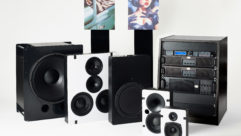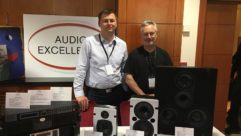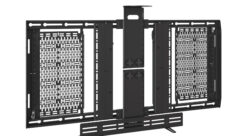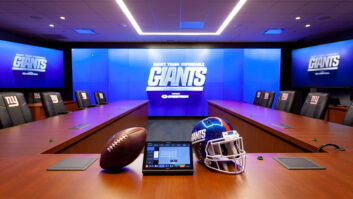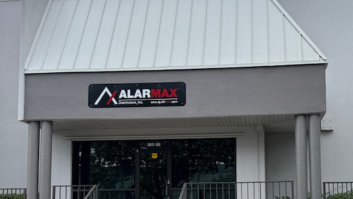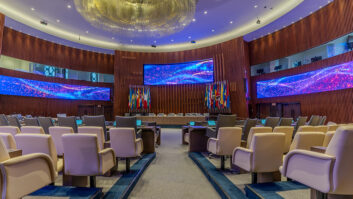
The Sound System Layout of Suffolk Theater
Sep 12, 2014 4:16 PM,
With Bennett Liles

Listen to the Podcast
Editor’s note: For your convenience, this transcription of the podcast includes timestamps. If you are listening to the podcast and reading its accompanying transcription, you can use the timestamps to jump to any part of the audio podcast by simply dragging the slider on the podcast to the time indicated in the transcription.
From Sound & Video Contractor Magazine, this is the SVC Podcast with Stuart Allyn of A.D.R. Studios. Show notes for the podcast can be found on the web site of Sound & Video Contractor Magazine at svconline.com.
A grand old movie theater gets a new life, a new look and an all-new Renkus-Heinz sound system designed by A.D.R. Studios in Irvington, New York. Company president Stuart Allyn is going to give us the story on how the system was set up to accommodate a range of different seating plans. All that’s right here on the SVC Podcast.
Stuart, thanks for joining us here on the SVC Podcast and you’re the head guy at A.D.R. Studios in, I believe it’s Irvington, New York.
Yes it is.
Okay, and we’re going to talk about this great, old theater that was completely renovated with new seating, new floor, new Renkus-Heinz sound system. Is this the kind of thing that A.D.R. Studios typically gets into or what sort of projects do you do?
We’ve been around for a long time and we provide a fairly large array of services. We do acoustical, audio, video, film and control system design, consulting, engineering, calibration, and tuning and we do it for residential and commercial clients and we also do some live event concert sound as well. [Timestamp: 1:27]
Well, I’m sure that keeps everybody busy and I looked at your web site. You’ve got enough people there to have somebody into every special area.
For sure.
I think this one was the Suffolk Theater, a beautiful place as it has turned out, with a new sound system.
Yes.
What are they doing in that place now? How’s it being used?
Actually it’s a lovely concept. The owners took this old, original 1930’s movie theater and decided to turn it into a live venue. Being an original movie theater, it had a very shallow stage because the only thing you needed there was the screen and the speakers that sit behind the screen – or actually then it was only a mono speaker, so things obviously have changed over the years. So there was a shallow stage and there was raked seating as was common in the day. And back then there was no surround sound, there were no subwoofers. There was none of that. To translate this into a modern performance venue, a lot of things needed to change and they wanted to have a very flexible seating situation. So their concept was to rip out the floor and instead of having a raked floor, have a terraced floor with about – I think there’s eight levels going from the dance floor, which is in front of the stage, all the way to the back. And then there’s also a small balcony that has about three or four also terraced levels on it. And by terracing it, they have the ability to set up tables and chairs for certain kinds of events or they can set it up theater-style seating or they can do a mix with some theater-style seats in the front and terraced seats and tables in the back or however they want to do it, which gives them all sorts of options for different kinds of events that they might want to have there. And they built the stage out to accommodate larger performance groups of all kinds, so they created a large apron in front of the stage. They couldn’t extend back, but they were able to extend forward. [Timestamp: 3:36]
I know that the tremendous variation in seating setups presented some big challenges to the sound system design.
For sure. The good news is that at least the terraces themselves are fixed so there’s certain limitations and the rear of the room is the rear of the room, and so that doesn’t change. And we went after it in a fairly classical way of designing left/right. We actually originally wanted to have a center set of speakers as well, but aesthetically that was not to be permitted so we stuck with a left/right pair of speakers on either side. And then we did a lot of fills, so there are front fills and under-balconies and over-balconies and then there’s audio carried through the rest of the building. So there’s an upper bar area, there’s a private skybox area, there’s the lobby areas and other areas that carry the sound through to all of it. [Timestamp: 4:34]
And I guess that brings us to big challenge number two which would be maintaining the classical décor of the place.
Oh, yeah. That was probably the second-biggest challenge after the budget which was always the first-biggest challenge. So there were a lot of things we wanted to do. First and foremost we wanted to treat the acoustics of the space as much as possible. That was able to be done. The original theater had some fabric on the walls in between these decorative art columns and the owners very much wanted to replicate that fabric. In fact they went on this world-wide search to try to find some company that would replicate this fabric. They did eventually and what we did was design acoustical fill to go behind the fabric, in between the columns on the walls, that would cover about 60 percent of the wall area, which helped tame down the very nasty reflections that would have been there otherwise. They didn’t want us to mess with the ceiling at all because the ceiling is quite intricate, so the ceiling remained a plaster ceiling. It does have some decorative beams, which fortunately also help provide some diffusion in the space. But treating the walls was a big step towards helping solve some of the acoustical problems, which then helped solve some of the speaker problems, so it all kind of played together. They also put a fair amount of nice carpeting in on most of the tiers, so that also helped. [Timestamp: 6:06]
So you went with Renkus-Heinz PNX and TRX speaker systems?
We did. Any time you design a space like this, choosing the equipment is also a big question. First of all there’s, fortunately for us, lots to choose from and it becomes a matter of balancing the best needs of all the disparate things that are kind of tugging at you. So you’ve got to find the things that have the right dispersion, that have the right powering and handling, that have the right physical footprint, that you can rig in the way you need them to rig and get them physically where you need to get them. And then find things that will fit the budget and then sort of first and last sound the way you want them to sound. So Renkus speakers have a beautiful natural sound, especially in the most important mid-range space, which is where the vocals are – which for me, especially in a concert venue, are critically important. And they’re nicely priced as compared to a lot of other things and we’ve had lots of success working with them in the past. It just kind of came together. We found the boxes with the right coverage that we could put in the right places. And the little TRX’s for over and under balconies are lovely things that have a very small footprint, very, very wide dispersion for covering over and under-balcony space and compliment, of course, the Renkus mains very nicely, so it all kind of ties together in a good way. Renkus also is very adept at color matching, so we were able to send them color samples – especially for the over and unders because those were going to be seen, and the aesthetics being as important as they were, Renkus was able to dead-perfect color match these to a particular shade of – I couldn’t tell you what it is in the color world; some sort of mauve or something. But anyway, they got it spot on and these things, even though they were physically there they are just about invisible even though they’re hanging right there in front of you. [Timestamp: 8:07]
The Sound System Layout of Suffolk Theater
Sep 12, 2014 4:16 PM,
With Bennett Liles
Those little things can fit just about any place. Under balcony seems to be a favorite spot for those. So who did all of the drilling, the wire dragging and the actual installation?
Theatrical Services was the installing contractor. They don’t exist any more pretty much. They were acquired by a company called Young Equipment Sales Corporation. But at the time of the install it was Theatrical Services. [Timestamp: 8:30]
And what turned out to be the hardest thing to deal with on this one? Was it the timeline? You mentioned the budget before.
Yeah, well the budget was extremely difficult to deal with. The prospect of renovating the theater had taken a lot longer and cost a lot more than the owners anticipated. No surprise, these things tend to be that way. And then faced with the realities of what a full-fledged audio, video, lighting and control system distributed throughout the building was gonna cost definitely put a serious stress on the owner and his concept of what all this stuff costs. But we were able to work with all the different vendors and all the different installers and everyone else involved to bring this in at a fairly reasonable price. And doing that you make a lot of compromises along the way but you try to maintain the quality of the system throughout, end-to-end, so that you don’t sacrifice a lot in any one area. You make lots of tiny little compromises so that the overall scheme of the project still maintains its integrity and has a complete design. And then the other big challenges were maintaining the aesthetic and staying out of the way of the look of the space, which we accomplished pretty well, and lastly was the timeline because again, the construction taking longer kept pushing the beginning of the install later and later and later and yet the grand opening was going to be when the grand opening was going to be. So the timeline kept shrinking and shrinking, as also tends to happen and we made it although it wasn’t absolutely 100 percent on the day it opened. There was a whole lot of little stuff that nobody noticed but that needed to get finished that then happened in the few months following the install.
And where is the sound control point set up?
There’s a main mixing – we’ll call front-of-house mix position – which is located balcony house left so you have a complete view of the stage and you can hear what the people in the balcony are hearing. You can hear from the mains. You can hear everything and you can see everything and you have an unobstructed view. And then there’s a stage manager’s control booth located directly behind that, which also has a full view and the lighting control is also in that same location. So all of that is controlled from that one sort of central location, but there are little Crestron touch panels scattered around that allow little bits of control from other locations when there isn’t a sort of main show going on. [Timestamp: 11:07]
Well, that’s probably a good idea especially for communication, having everybody pretty close by. Did you have any trouble setting up delay in the room since the seating arrangement can be varied so widely?
Well the good news is the stage is where the stage is and the assumption we made was that all performance would emanate from the stage. So setting up all the timing and time delays of all the speakers, we just time zeroed the upstage center of the stage as time zero and delayed everything appropriately from there so that everything times out to upstage center. There occasionally might be some announcers or people standing just downstage of the stage itself on the dance floor, for example, but so far the timing is short enough, because the distance is small enough that that hasn’t presented a problem. [Timestamp: 12:00]
I know this had to be an interesting job and the picture I saw of it, the place really looks spectacular.
Yeah. It came out great. The owners did an absolutely spot-on, wonderful job of restoring the place. They restored all the light fixtures – the original light fixtures – and matched the paint colors and the fabric, like I said before, in ways that very few people short of Disney at the New Amsterdam Theater go to those kinds of lengths to get things right. But they were very, very dedicated to getting it right and making it all look and feel the way it ended up looking and feeling. The photographs that have been published and that are on their website and stuff like that speak to what a great job they did. [Timestamp: 12:45]
Okay, you got this one done and what’s coming up next for A.D.R. Studios?
A lot of stuff. We’re fortunately very nicely busy. We’re working with the town of Huntington on their Town Hall and redoing that both acoustically and visually. We’re redesigning seating and sound and video and so on. We’re working with a couple of Long Island high schools addressing their acoustical issues and also their AV systems. We’re working on a couple of private residences both in the city and in Connecticut, and we’re working with a large jewelry store in Manhattan on some audio and some digital signage, some offices, some conference rooms, a church in Florida and we have three ongoing concert series that we provide sound for – one in New York City, one in Blooming Grove and one in Barbados. [Timestamp: 13:35]
Alright, so we know things aren’t going to be dull for a while.
No, not in the least.
Stuart Allyn, president of A.D.R. Studios, in Irvington, New York and the new life for the Suffolk Theater with a Renkus-Heinz sound system. It was good hearing about this one.
Well thank you. It was a pleasure to be here and I look forward to talking to you more in the future about other stuff.
Thank you for being with us for the SVC Podcast with Stuart Allyn of A.D.R. Studios. Show notes are available on the web site of Sound & Video Contractor Magazine at svconline.com. Be back with us again for the next SVC Podcast.


